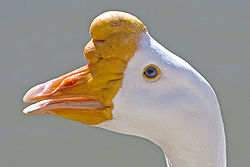
This is a list of breeds of domestic goose; species with semi-domestic populations are included. Geese are bred mainly for their meat, which is particularly popular in Germanic languages countries around Christmas. Of lesser commercial importance is goose breeding for eggs, schmaltz, or for the fattened liver ( foie gras ). A few specialized breeds have been created for the main purpose of weed control (e.g. the Cotton Patch Goose), or as guard animals and (in former times) for goose fights (e.g., the Steinbach Fighting Goose and Tula Fighting Goose).
Contents
- Breeds
- Breeds derived from the greylag goose
- Breeds derived from the swan goose
- Auto-sexing goose
- Semi-domesticated goose species
- Footnotes
- References
- External links
Goose breeds are usually grouped into three weight classes: heavy, medium and light. Most domestic geese are descended from the greylag goose (Anser anser). The Chinese and African Geese are the domestic breeds of the swan goose (A. cygnoides); they can be recognized by their prominent bill knob. [1]
Some breeds, like the Obroshin Goose and Steinbach Fighting Goose, originated in hybrids between these species (the hybrid males are usually fertile – see Haldane's Rule). In addition, two goose species are kept as domestic animals in some locations, but are not completely domesticated yet and no distinct breeds have been developed.




